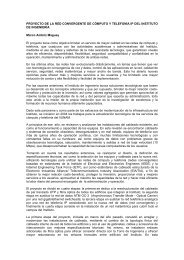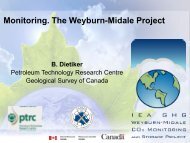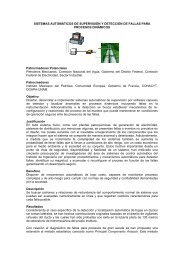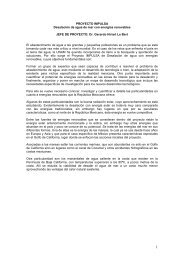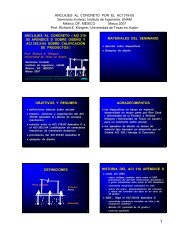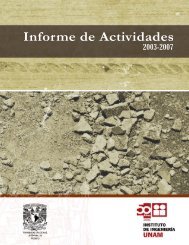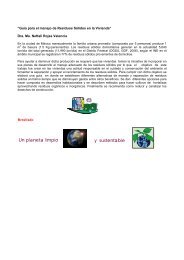pseudo dynamic performance of large scale buckling restrained ...
pseudo dynamic performance of large scale buckling restrained ...
pseudo dynamic performance of large scale buckling restrained ...
You also want an ePaper? Increase the reach of your titles
YUMPU automatically turns print PDFs into web optimized ePapers that Google loves.
θyi= 2 ⋅εcyγ ⋅sin 2φ(4)where ε cy is the yielding strain <strong>of</strong> the brace center cross section, γ is the ratio between a specificelastic axial strain <strong>of</strong> the brace center segment and the corresponding elastic averaged strain <strong>of</strong>the entire braceε wp (computed from the brace end work-point to work-point length). ψ is theangle between the horizontal beam and the brace. θ is the story drift angle, ε c is the strain <strong>of</strong> thebrace steel core section and α c =L c /L wp (L c and L wp are defined in Fig. 13). Thus, if θ mi is thetarget drift <strong>of</strong> the i th story calculated from the target displacement pr<strong>of</strong>ile, then the story ductilitycan be computed from:µ = θ / θ(5)imiyiAfter calculating all the story ductilities from Eq. 5, the average <strong>of</strong> all story ductilities is taken asthe system ductility. Since the BRBs are the primary energy dissipation element under the twolevels <strong>of</strong> earthquakes, the connecting beams and the columns need to be designed consideringthe capacity design requirements. Typical force versus deformation relationships for A572 Gr.50steel BRB specimens, is shown with actual yield capacity (A c ×F y,actual ) in Fig. 14 (Tsai and Lin2003). It is evident that the peak compressive force is slightly <strong>large</strong>r than the peak tensile forceunder <strong>large</strong> cyclic increasing strains. In addition, the strain hardening factor <strong>of</strong> Grade 50 steel isabout 1.3. Therefore, the maximum possible brace force can be estimated as follows:Pmax= β × Ω × Ω h× P y(6)where P y is the nominal tensile yield strength, Ω accounts for possible material overstrength, Ω hrepresents the effects <strong>of</strong> strain hardening, and β is about 1.1 considering the 10% differencebetween the peak compressive and tensile forces. Since the actual yield strength obtained fromthe tensile coupon tests was employed to adjust the final BRB cross sectional area beforefabrication, the material overstrength factor Ω is not included in the capacity design <strong>of</strong> membersor connections for the BRBF specimen. Applying LRFD specifications (AISC, 1999):8 ⎡⎛P ⎞ ⎤Pu/( φcPn) ≥0. 2 : Pu/( φcPn) + Mu/ ⎢ 1⎥ ≤ 1. 09⎜ −⎟φbM(7)n⎣⎝Pe⎠ ⎦22where P = F A , = π EI /( kl ) , φ 0.75( tension)or 0.85( compression), φ = 0. 9 . TwoncrgP crc =hazard levels considered in this study, for the 10/50 and 2/50 events, the inter-story drift limitsare set at 0.02 and 0.025 radians, respectively. The actual material test results given in Table 2can be used to refine the estimations <strong>of</strong> the ductility demand. With the actual steel core strengthand assume the length ratio α ci for braces at 1 st - and 2 nd - floor as 0.7 and 0.6, respectively, theaveraged system ductility demands for the 10/50 and 2/50 events are 5.39 and 6.74, respectively(shown in Table 3). Applying the target displacement pr<strong>of</strong>ile obtained in the Step 2, the effectivedisplacement δ eff is 0.13 m and 0.17 m for the 10/50 event and 2/50 event, respectively.Intersecting the effective target displacements <strong>of</strong> 0.13 m and 0.17 m on the inelasticdisplacement response spectra shown in Fig. 15, the effective first vibration period (T eff ) 1 duringthe 10/50 and 2/50 events can be found as 1.19 and 1.22 second, respectively. In Fig. 15, the6b
elastic displacement response spectrum (µ=1.0) is also given. Based on the results computed bythe aforementioned Steps 5 and 6, the design base shears, 4149.8 kN (=0.24W) and 4509.4 kN(=0.26W) represent the stage <strong>of</strong> significant system yielding for the two events. It is evident thatthe 2/50-0.025 hazard/<strong>performance</strong> criteria govern the design. In the transverse direction (Ydirection),the stiffness ratio (SR) <strong>of</strong> the BRBF and the MRF is assumed 3, thus the BRBF resists75% design earthquake force. Using this criterion, the core cross-sectional areas <strong>of</strong> the A572Gr.50 steel BRB are 50cm 2 and 33cm 2 for the 1 st - and 2 nd -story, respectively. Using the capacitydesign principle, more than 14x24-mm diameter A490 bolts would be required for each firststory BRB connection. In order to reduce the length <strong>of</strong> the connection, welded brace-to-gussetconnection details are adopted. For the BRB in the second story, bolted details using 10-24mmφA490 bolts are adopted at each brace end. After a few iterations, the final dimensions <strong>of</strong> thebraces and other members are selected as shown in Fig.16. In particular, the BRBs will yield inthe proximity <strong>of</strong> the design story shear. The vibration periods are 0.69sec and 0.57sec in thelongitudinal (MRF, noted as X-direction) and transverse (BRBF+MRF, noted as Y-direction)directions, respectively.Scaling Ground Motions and Experimental ProgramBased on the IBC2000 provisions (ICC, 2000) and the recommendations provided by Shome etal. (1998), for each pair <strong>of</strong> (bi-lateral) horizontal ground motion components, the square root <strong>of</strong>the sum <strong>of</strong> the square (SRSS) <strong>of</strong> the 5% damped site-specific spectra <strong>of</strong> the <strong>scale</strong>d horizontalcomponents was constructed first. The ground motions were <strong>scale</strong>d such that the spectralacceleration <strong>of</strong> the SRSS spectra was not less than 1.4 times the 5% damped smoothed designspectra at the fundamental period <strong>of</strong> the prototype building in the considered direction. Inaddition, the scaling factor (denoted as SF) should not exceed 4.0. Two pairs <strong>of</strong> earthquakerecords from the 1999 Chi-Chi earthquakes, CHY024 and TCU076 have been chosen as inputground motions. The corresponding spectra representing 10/50 and 2/50 hazard levels andsatisfying the above mentioned requirements are shown in Fig. 12. The earthquake scenario,including the earthquake intensities and sequence, for Phase I tests is shown in Fig. 17. Figure 18shows three earthquake ground accelerations which are 50/50 (CHY024), 10/50 (TCU076), and2/50 (CHY024) in the longitudinal and transverse directions. The gravity forces for the BRBFspecimen are applied by using the post-tension steel rods anchored at the strong floor (Fig. 10)and connected to a cross beam on top <strong>of</strong> each column. The force responses <strong>of</strong> the 2-story BRBFwere combined with all other finite element forces <strong>of</strong> the entire structure before solving all thenodal displacements for the next time step. The global target nodal displacements weretransformed incorporating the actuators’ orientation (Wang et al. 2005). Once the target actuatordisplacements have been reached, the force responses <strong>of</strong> the BRBF was measured andincorporated into the complete structural force response for solving next set <strong>of</strong> nodaldisplacements. Any difference on the force responses from the analytical BRBF (Fig. 10) and theexperimental BRBF specimen will result in the torsional responses <strong>of</strong> the entire building. Thus,torsional responses were investigated by purposely differentiate the stiffness and strength <strong>of</strong> theanalytical BRBF and the experimental BRBF. The torsional responses <strong>of</strong> the entire structurehave been avoided in the Phase I test by assuming the analytical BRBF’s force responses areidentical to those <strong>of</strong> the experimental BRBF.7
Analytical Predictions and Key Experimental ResponsesAnalytical ModelNonlinear static and <strong>dynamic</strong> time-history analyses have been conducted using the PISA3Dprogram (Tsai and Lin, 2003). In the PISA3D model, all beams, columns were modeled usingthe two-surface plastic strain hardening beam-column element. All BRBs were modeled usingthe two-surface plastic strain hardening truss element. The 2 nd order effects developed in thegravity columns are also considered. Analytical predictions <strong>of</strong> key structural responses, such asfloor displacement and story shear time histories were broadcasted through Internet(http://substructure-brbf.ncree.org) along with the experimental responses during the course <strong>of</strong>each test. Typical Internet plots are shown in Fig. 19.Phase I TestsIn Phase 1, as noted above, three pairs <strong>of</strong> earthquake ground accelerations <strong>scale</strong>d to threedifferent PGAs were applied for the sub-structural PDT <strong>of</strong> the BRBF specimen. The predictedand experimental distributions <strong>of</strong> the peak inter-story drifts under the applications <strong>of</strong> 50/50,10/50 and 2/50 three earthquake loads are shown in Figs. 20 and 21 for the X and Y directions,respectively. It is shown that the experimental peak inter-story drifts <strong>of</strong> 1 st - and 2 nd -story in bothdirections were satisfactorily predicted. In particular, the design inter-story drift target <strong>of</strong> 0.025radian for the 2/50 events, has been reached in the transverse direction. Other test results can beconveniently found in the web site (http://substructure-brbf.ncree.org) during and after the tests.Phase II Tests and Cyclic Loading TestsAt the end <strong>of</strong> applying the 50/50, 10/50 and 2/50 earthquake ground accelerations, base metalcracks were observed at the tip <strong>of</strong> two gusset plate welded joints. In the Phase II tests, theprototype structure was adjusted to form an asymmetric structure, which has the commonexperimental BRB frame on Frame Line B. Two additional 2/50 hazard level earthquake loadswere subsequently applied on the BRBF. Thus, the BRBF was subjected to five bi-directionalearthquake ground accelerations <strong>scale</strong>d to three different hazard levels, namely one 50/50,one10/50 and three 2/50 events. However, it is illustrated that the BRBF specimen sustainedthese five <strong>pseudo</strong> <strong>dynamic</strong> loading without global stiffness or strength degradation. Finally, twosets <strong>of</strong> mutually orthogonal, bi-directional cyclic increasing inter-story drifts were imposed untilthe first story BRB-to-beam and column joint was completely fractured at the second cycle <strong>of</strong>0.03 radian. No gusset plate instability was observed through out the bi-directional hybrid andcyclic tests.ConclusionsBased on the 2-story BRBF tests, summary and conclusions are made as follows:1. The peak story drift has reached 0.025 radian in the transverse direction in Phase I tests afterapplying the 2/50 design earthquake on the BRBF specimen. Tests suggest that the DSDprocedure adopted in the design <strong>of</strong> the specimen is effective in limiting the ultimate story driftunder the design earthquake.2. The peak story drift has reached 0.015 radian in the longitudinal building (BRBF’s out-<strong>of</strong>plane)direction in Phase I tests. It appears that all the gusset plates sustained these moderateout-<strong>of</strong>-plane deformational demands without failure.3. These tests and ABAQUS analysis confirmed that the stiffeners arranged for the gusset plates8
are effective, and have made an effective length factor <strong>of</strong> K=1.0 appropriate in computing thecompressive gusset strength.4. It is illustrated that the real-time webcast <strong>of</strong> the test results is extremely effective forresearchers to understand the responses <strong>of</strong> the specimen during the tests.AcknowledgementsThe author would like to acknowledge the financial supports <strong>of</strong> the National Science Council.The technical supports provided by the laboratory at NCREE are gratefully acknowledged. ManyNCREE staffs and NTU graduate students made significant contributions to the success <strong>of</strong> thesestudies. It includes Wei-Chung Cheng, Po-Chien Hsiao, Yean-Chih Huang, Juin-Wei Lai, Bo-Zhou Lin, Min-Lang Lin, Jui-Liang Lin, Shen-Ling Lin, Cheng-Yu Tsai, Kung-Juin Wang,Yuan-Tao Weng, Chong-Shing Weng and Min-Jie Zhuang. Without their efforts, these researchresults would not be possible. Valuable suggestions provided by Pr<strong>of</strong>. Stephen Mahin <strong>of</strong>University <strong>of</strong> California at Berkeley, Pr<strong>of</strong>. Charles Roeder <strong>of</strong> University <strong>of</strong> Washington, Mr.Rafael Sabelli <strong>of</strong> DASSE Design Inc. on the gusset plate design <strong>of</strong> the 2-story BRBF aregratefully acknowledged.ReferencesABRI, (2002). Recommended Provisions Updated Draft for Building Seismic Regulations, Taipei, 2002(in Chinese).AISC(American Institute <strong>of</strong> Steel Construction), (1999). Seismic Provisions for Structural Steel Buildings,Chicago, IL, 1997.Chen, C.H., Hsiao, P.C., Lai, J.W., Lin, M.L., Weng, Y.T., and Tsai K.C. (2004). “Pseudo-Dynamic Test<strong>of</strong> a Full-Scale CFT/BRB Frame: Part 2 - Construction and Testing.” Proceedings <strong>of</strong> 13th WorldConference on Earthquake Engineering, Vancouver, B.C., Canada, Paper No. 2175.Chopra, A.K. and Goel, R. K. (2004).“A modal pushover analysis procedure to estimate seismic demandsfor unsymmetric-plan buildings." Earthquake Engineering and Structural Dynamics 33, 903-927.ICBO, (2000). Internal Building Code, Whittier, CA.Lin, M.L., Weng, Y.T., Tsai, K.C., Hsiao, P.C., Chen, C.H. and Lai, J.W. (2004). “Pseudo-Dynamic Test<strong>of</strong> a Full-Scale CFT/BRB Frame: Part 3 - Analysis and Performance Evaluation.” Proceedings <strong>of</strong> 13thWorld Conference on Earthquake Engineering, Vancouver, Canada. Paper No. 2173.Lin, M.L., Tsai, K.C., Hsiao, P.C. and Tsai, C.Y., “Compressive behavior <strong>of</strong> <strong>buckling</strong> <strong>restrained</strong> bracegusset connections”, First Conference on Advanced in Experimental Structural Engineering (AESE),Nagoya, Japan, 2005.Mahin, S. A. and Lin, J. (1983). Construction <strong>of</strong> Inelastic Response Spectra for Single-Degree-<strong>of</strong>-Freedom Systems : Computer Program and Applications (Report No. UCB/EERC-83/17), EarthquakeEngineering Research Center, University <strong>of</strong> California.Shome, N., Cornell, C. A., Bazzurro, P. and Carballo, J. E. (1998). “Earthquake, records, and nonlinearresponses.” Earthquake Spectra, Vol.14, No.3, 469-497.Tsai. C. Y., Lin, M. L., and Tsai, K. C. (2005) “Design <strong>of</strong> a full <strong>scale</strong> two-story steel <strong>buckling</strong> <strong>restrained</strong>braced substructure for 3D hybrid tests.” Proceeding, The 3 rd Annual KKN Student Seminar on CivilEngineering Research, Cheju-island, Korea.Tsai, K.C., and Lin, B.Z. (2003a). User Manual for the Platform and Visualization <strong>of</strong> Inelastic StructuralAnalysis <strong>of</strong> 3D Systems PISA3D and VISA3D (Report No. CEER/R92-04), Center for EarthquakeEngineering Research, National Taiwan University.9
Tsai, K.C. and Lin, S.L, (2003b). A Study <strong>of</strong> All Metal and Detachable Buckling Restrained Braces(Report No. CEER/R92-03), Center for Earthquake Engineering Research, National Taiwan University.Tsai, K.C., Weng, Y.T., Lin, S.L., and Goel, subhash. (2004). “Pseudo-Dynamic Test <strong>of</strong> a Full-ScaleCFT/BRB Frame: Part 1 - Performance Based Specimen Design.” Proceedings <strong>of</strong> 13th WorldConference on Earthquake Engineering, Vancouver, B.C., Canada, Paper No. 750.Tsai, K.C., Hwang, Y.C., Weng, C.S, Shirai, T, and Nakamura, H. (2002). “Experimental Tests <strong>of</strong> LargeScale Buckling Restrained Braces and Frames.” Proceedings, Passive Control Symposium 2002, TokyoInstitute <strong>of</strong> Technology, Tokyo.Thornton, W.A. (1984). “Bracing Connections for Heavy Construction.” Engineering Journal <strong>of</strong> AISC,Vol.21, No.3, pp. 139~148.Uang, C.M., Nakashima, M. and Tsai, K.C. (2004). “Research and Applications <strong>of</strong> Buckling RestrainedBraced Frames.” International Journal <strong>of</strong> Steel Structures, 4/2004.Wang. K. J., Wang, S. J., Cheng, W. C.,Yang, Y. S. and Tsai, K. C. (2005) “A platform for networkedcollaborative structural experiments.” the First Conference on Advanced in Experimental StructuralEngineering (AESE), Nagoya, Japan, 2005.Whitmore, R.E. (1952). Experimental Investigation <strong>of</strong> Stresses in Gusset Plates, Bulletin No.16,Engineering Experiment Station, University <strong>of</strong> Tennessee.Weng, Y. T., Lin, J. L., Tsai, C. Y., and Tsai, K. C. (2005). “Analytical assessment <strong>of</strong> a 2-story BRBF forfull-<strong>scale</strong> 3D sub-structural <strong>pseudo</strong>-<strong>dynamic</strong> testing.” the First Conference on Advanced inExperimental Structural Engineering (AESE), Nagoya, Japan.1F3FTable 1 Capacity check <strong>of</strong> gusset platesGusset Plate (kN)PPcrPcry Gusset(K=2.0) (K=0.65)BRB (kN)PyBracePmaxTop 2287 842 7975 1558 1713Bottom 2287 1367 12939 1558 1713Top 1397 603 5709 686 755Bottom 1397 743 7036 686 755A572 Gr.50Table 2 Material test resultsPositions <strong>of</strong> Sampling f y (MPa) f u (MPa)2FL BRB2 core steel 367.9 523.91FL BRB1 core steel 371.8 512.1StoryTable 3 Computation <strong>of</strong> story ductility and system ductilityStory Ductility10/50 2/50αciθyiθθmiyiµiunit : 1/1000 radunit : 1/1000 rad2F 0.70 3.49 20 5.73 3.49 25 7.161F 0.60 3.93 20 5.08 3.93 25 6.35Average 3.71 20 5.39 3.71 25 6.74θmiµi10
Table 4 The member sizes and properties <strong>of</strong> BRBA cA tA jα ci(mm 2 ) (mm 2 ) (mm 2 ) (mm) (mm) (mm) (mm)γBRB1 0.6 5000 8100 11200 6201 520 2081 8802 1.18BRB2 0.7 3300 6226 9152 5396 450 3101 8947 1.33L cL tL jL wp3@2.33m2@ 3.5m3@2.33m3@4m2.15 mTube400-9H400x200x8x13H450x200x9x14H456x201x10x17Pipe400-9BRB CoreArea=15cm 2BRB CoreArea=25cm 2BRB CoreArea=30cm 2Pipe400-9H400x200x8x13H450x200x9x14Tube400-9H456x201x10x17Acceleration(m/sec 2 )1050-5-103@7m(a)Fig. 1 (a) Plan and elevation <strong>of</strong> the full-<strong>scale</strong> CFT/BRB composite frame(b) Photo <strong>of</strong> the CFT/BRB frame specimenPhase112.62secTest No.1TCU08250/50Test No.2TCU08250/50Test No.3LP89g0410/50Test No.5TCU0822/5012.54secTest No.5TCU0822/50Test No.6LP89g0410/500 50 100 150 200 250 300Time (sec)Acceleration(m/sec 2 )-10Fig. 2 Ground acceleration time history in PDTs1050-5(b)Test No.1TCU08210/50Phase2Test No.2LP89g042/500 25 50 75Time (sec)(a)(b)Fig. 3 (a) Out-<strong>of</strong>-plane <strong>buckling</strong> <strong>of</strong> the gusset plate (b) Gusset plate after adding stiffeners11
Fig. 4 (top two) Original design <strong>of</strong> the gusset plate (bottom 2) Details <strong>of</strong> added stiffenersFig. 5 Buckling <strong>of</strong> the gusset at thebrace to column joint after Phase-1 testsFig. 6 Added stiffeners at the free edges <strong>of</strong> the gusset at thebrace to column joint before Phase-2 teststb e30°L 2L 1L 3K < 2.0 K= 0.65Fig. 7 Whitmore’s and Thornton’s designmethodologies(a) (b) (c) (d)Fig. 8 Brace boundary conditions and <strong>buckling</strong>modes12
Fig. 9 (a) FE Model <strong>of</strong> un-stiffened gusset plate (b) FE Model <strong>of</strong> stiffened gusset plate8 mY4.00Z4.00(XDir(b) YDirFig.10 Sub-structural BRBF elevation and floor framing plan <strong>of</strong> the prototype 3D steel frame13
Fig. 11 Details at the gusset plate connectionsSa (g)2.521.510.5(PGA) TCU076EW=0.37g(PGA) TCU076NS=0.46gTCU076EWTCU076NSTCU076SRSS1.4*RP475ξ=5%Sa (g)321(PGA) CHY024EW=0.67g(PGA) CHY024NS=0.39gCHY024EWCHY024NSCHY024SRSS1.4*RP2500ξ=5%Axial Force ( kN )3000200010000-1000-2000ExperimentAnalysis1.25 PyPyL j/2joint sectionW.P.00 0.4 T y 0.8 1.2 1.6 2Period (sec)(Fig. 12 Design acceleration spectra (a)10/50 (b)2/50 hazardlevel in Phase 1 PDTsUnbondingMaterialsCore SteelMemberConcrete(Mortar)TabPlateSteel Tube(Buckling Restrained Part)transition sectionBucklingRestrainedBraceL t/2 L cL t/2 L j/2steel core sectionjoint sectionL wp00 0.4 T y 0.8 1.2 1.6(2Period (sec)W.P.Fig.13 Pr<strong>of</strong>iles <strong>of</strong> core steel in the BRB14System displacement (cm)5040302010-3000-0.03 -0.02 -0.01 0 0.01 0.02 0.03Core StrainFig.14 Force versus core strainrelationship <strong>of</strong> BRB using A572Gr.50 steelHard Rock Soil Siteµ=5.39 (For 10/50-0.02)µ=6.74 (For 2/50-0.025)µ=1, (For 10/50-0.02)µ=1, (For 2/50-0.025)(δ eff) 10/50(δ eff) 2/50For 10/50-Tri, (Τ eff) 1=1.19 secFor 2/50-Tri, (Τ eff) 1=1.22 sec00 0.4 0.8 1.2 1.6 2Period (sec)Fig.15 Inelastic design displacementspectra
Column: H400x400x20x35mm (A572.Gr.50)Beam: H600x300x14x23mm (A36)Column: H350x350x20x33mm (A572.Gr.50)Beam: H600x300x12x17mm (A36)Core cross sectional areas <strong>of</strong> the BRBs are33 and 50 cm 2 at the 2 nd and 1 st story.H600×300×14×23H600×300×12×17H482×300×11×15Ac=33cm 2H488×300×11×18H400×400×20×35H350×350×20×33Ac=50cm 2(b) Frame Elevation – Frame Line A and EH350×350×12×19(a) Frame Elevation – Frame Line 1 and 4(c) Frame Elevation – Frame B and DFig. 16 Beam and column sizes in the MRF and BRBFY Dir.YCHY024N CMXSCHY024EWYTCU076E CMXWTCU076NSYCHY024N CMXSCHY024EWElastic CyclicTestPDT No.150/50 risk levelPDT No.210/50 riskPDT No.32/50 risk levelFig. 17 Earthquake scenario for Phase I <strong>of</strong> testAcceleration (g)0.50.40.30.20.10-0.1-0.2-0.3-0.4-0.5PDT No.1CHY024NSPGA=0.10gPhase I, X Dir.PDT No.2TCU076EWPGA=0.37g0 30 60 90 120 150Time (sec)(a)PDT No.3CHY024NSPGA=0.39gAcceleration (g)(a)0.70.60.50.40.30.20.1-0.1 0-0.2-0.3-0.4-0.5-0.6PDT No.1CHY024EWPGA=0.18gPhase I, Y Dir.PDT No.2TCU076NSPGA=0.46g-0.70 30 60 90 120 150Time (sec)(b)PDT No.3CHY024EWPGA=0.67g(b)Fig.18 Ground acceleration time history involving three earthquake events for Phase I <strong>of</strong> test(a) X-Direction (b) Y-Direction15
Fig. 19 Typical Internet plots <strong>of</strong> experimental responses and analytical predictions, left: X versusY ro<strong>of</strong> displacement, right: Y-direction ro<strong>of</strong> displacement time history2CHY024NS(50/50)0.10g2TCU076EW(10/50)0.37g2CHY024NS(2/50)0.39gFloor1EXP.PISA3DFloor1EXP.PISA3DFloor1EXP.PISA3DSPDT No.1X-dir.0-0.6 -0.4 -0.2 0 0.2 0.4 0.6Story Drift (radian %)SPDT No.2X-dir.0-1.5 -1 -0.5 0 0.5 1 1.5Story Drift (radian %)SPDT No.3X-dir.0-2 -1 0 1 2Story Drift (radian %)Fig. 20 Peak X-direction inter-story drift distribution <strong>of</strong> BRB frame specimen in three hazardlevelsFloor21CHY024EW(50/50)0.18gEXP.PISA3DFloor21TCU076NS(10/50)0.46gEXP.PISA3DFloor21CHY024EW(2/50)0.67gEXP.PISA3DSPDT No.1Y-dir.0-0.8 -0.4 0 0.4 0.8Story Drift (radian %)SPDT No.2Y-dir.0-1.5 -1 -0.5 0 0.5 1 1.5Story Drift (radian %)0SPDT No.3Y-dir.-3 -2 -1 0 1 2 3Story Drift (radian %)Fig. 21 Peak Y-direction inter-story drift distribution <strong>of</strong> BRB frame specimen in three hazardlevels16



